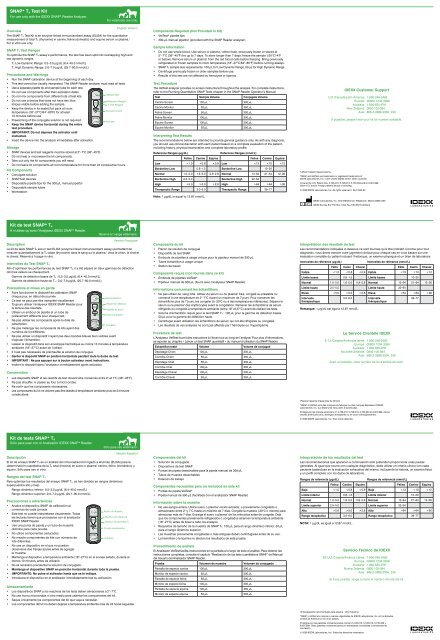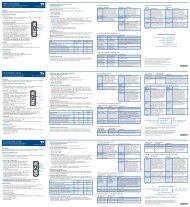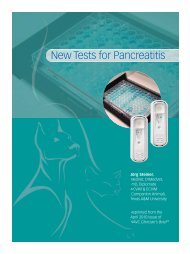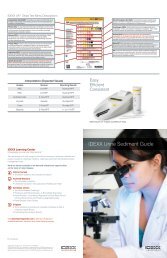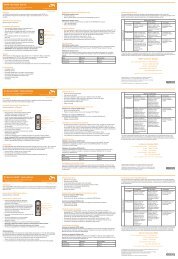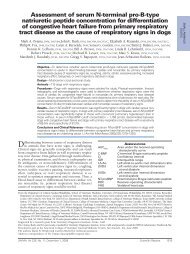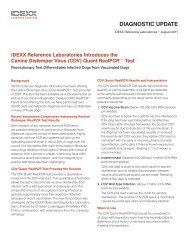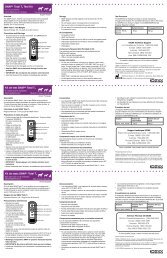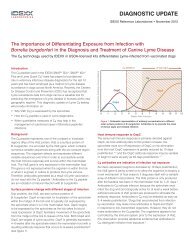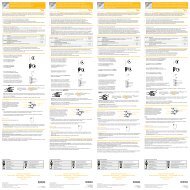SNAP* T4 Test Kit Kit de test SNAP* T4 Kit de tests SNAP* T4
SNAP* T4 Test Kit Kit de test SNAP* T4 Kit de tests SNAP* T4
SNAP* T4 Test Kit Kit de test SNAP* T4 Kit de tests SNAP* T4
Create successful ePaper yourself
Turn your PDF publications into a flip-book with our unique Google optimized e-Paper software.
<strong>SNAP*</strong> T 4 <strong>Test</strong> <strong>Kit</strong><br />
For use only with the IDEXX <strong>SNAP*</strong> Rea<strong>de</strong>r Analyzer.<br />
For veterinary use only.<br />
English Version<br />
Overview<br />
The SNAP T 4 <strong>Test</strong> <strong>Kit</strong> is an enzyme-linked immunosorbent assay (ELISA) for the quantitative<br />
measurement of total T 4 (thyroxine) in canine, feline (domestic) and equine serum or plasma. †<br />
For in vitro use only.<br />
SNAP T 4 <strong>Test</strong> Ranges<br />
To optimize the SNAP T 4 assay’s performance, the <strong>test</strong> has been split into overlapping high and<br />
low dynamic ranges.<br />
T 4 Low Dynamic Range: 0.5–3.5 µg/dL (6.4–45.0 nmol/L)<br />
T 4 High Dynamic Range: 2.0–7.0 µg/dL (25.7–90.0 nmol/L)<br />
Precautions and Warnings<br />
• Run the SNAP calibration <strong>de</strong>vice at the beginning of each day.<br />
• This <strong>test</strong> cannot be visually interpreted. The SNAP Rea<strong>de</strong>r analyzer must read all <strong>test</strong>s.<br />
• Use a separate pipette tip and sample tube for each <strong>test</strong>.<br />
• Do not use components after their expiration dates.<br />
• Do not mix components from different lots of <strong>test</strong> kits.<br />
Sample Well<br />
• Do not use a <strong>de</strong>vice that does not have two blue<br />
stripes visible before adding the sample.<br />
Reference Reagent<br />
<strong>T4</strong> <strong>Test</strong> Reagent<br />
• Keep the <strong>de</strong>vice in its sealed foil pack at room<br />
temperature (18°–27°C/64°–80°F) for at least<br />
10 minutes before use.<br />
Activation Circle<br />
• Prewarming of the conjugate solution is not required.<br />
Activator<br />
• Keep the SNAP <strong>de</strong>vice horizontal during the entire<br />
<strong>test</strong> procedure.<br />
• IMPORTANT: Do not <strong>de</strong>press the activator until<br />
instructed.<br />
• Insert the <strong>de</strong>vice into the analyzer immediately after activation.<br />
Storage<br />
• SNAP <strong>de</strong>vices and <strong>test</strong> reagents must be stored at 2°–7°C (36°–45°F).<br />
• Do not heat or microwave the kit components.<br />
• Take out only the kit components you will need.<br />
• Do not leave kit components at room temperature for more than 24 consecutive hours.<br />
<strong>Kit</strong> Components<br />
• Conjugate solution<br />
• SNAP <strong>test</strong> <strong>de</strong>vices<br />
• Disposable pipette tips for the 300-µL manual pipettor<br />
• Disposable sample tubes<br />
• Workstation<br />
Components Required (Not Provi<strong>de</strong>d in <strong>Kit</strong>)<br />
• Vet<strong>Test</strong>* pipette tips<br />
• 300-µL manual pipettor (provi<strong>de</strong>d with the SNAP Rea<strong>de</strong>r analyzer)<br />
Sample Information<br />
• Do not use whole blood. Use serum or plasma, † either fresh, previously frozen or stored at<br />
2°–7°C (36°–45°F) for up to 7 days. To store longer than 7 days, freeze the sample (-20°C/-4°F<br />
or below). Remove serum or plasma † from the red blood cells before freezing. Bring previously<br />
refrigerated or frozen samples to room temperature (18°–27°C/64°–80°F) before running assays.<br />
• SNAP T 4 sample size requirements: 100 µL for Low Dynamic Range, 50 µL for High Dynamic Range.<br />
• Centrifuge previously frozen or ol<strong>de</strong>r samples before use.<br />
• Results of this <strong>test</strong> are not affected by hemolysis or lipemia.<br />
<strong>Test</strong> Procedure<br />
The Vet<strong>Test</strong> analyzer provi<strong>de</strong>s on-screen instructions throughout the analysis. For complete instructions,<br />
refer to the Running Quantitative SNAP <strong>Test</strong>s chapter in the SNAP Rea<strong>de</strong>r Operator’s Manual.<br />
<strong>Test</strong> Sample Volume Conjugate Volume<br />
Canine Screen 100 µL 300 µL<br />
Canine Monitor 50 µL 300 µL<br />
Feline Screen 50 µL 300 µL<br />
Feline Monitor 100 µL 300 µL<br />
Equine Screen 100 µL 300 µL<br />
Equine Monitor 50 µL 300 µL<br />
Interpreting <strong>Test</strong> Results<br />
The recommendations below are inten<strong>de</strong>d to provi<strong>de</strong> general guidance only. As with any diagnosis,<br />
you should use clinical discretion with each patient based on a complete evaluation of the patient,<br />
including history, physical examination and complete laboratory profile.<br />
Reference Ranges (µg/dL)<br />
Reference Ranges (nmol/L)<br />
Feline Canine Equine Feline Canine Equine<br />
Low 36<br />
Therapeutic Range 3.0–6.0 Therapeutic Range 39–77<br />
Note: 1 µg/dL is equal to 12.87 nmol/L.<br />
†<br />
Lithium heparin-based plasma.<br />
*SNAP and Vet<strong>Test</strong> are tra<strong>de</strong>marks or registered tra<strong>de</strong>marks of<br />
IDEXX Laboratories, Inc. in the United States and/or other countries.<br />
Covered by U.S. Patent Nos. 5,726,010; 5,726,013; 5,750,333 and/or 6,007,999.<br />
Other U.S. and/or foreign patents issued or pending.<br />
© 2008 IDEXX Laboratories, Inc. All rights reserved • 06-17600-00<br />
IDEXX Customer Support<br />
U.S./Canada/Latin America: 1-800-248-2483<br />
Europe: 00800 1234 3399<br />
Australia: 1-800-655-978<br />
New Zealand: 0800-102-084<br />
Asia: 886-2-2888-3336, 230<br />
If possible, please have your kit lot number available.<br />
IDEXX Laboratories, Inc. One IDEXX Drive, Westbrook, Maine 04092 USA<br />
IDEXX Europe B.V. P.O. Box 1334, NL-2130 EK Hoofddorp<br />
<strong>Kit</strong> <strong>de</strong> <strong>test</strong> <strong>SNAP*</strong> T 4<br />
À n’utiliser qu’avec l’Analyseur IDEXX <strong>SNAP*</strong> Rea<strong>de</strong>r.<br />
Réservé à l’usage vétérinaire.<br />
Version Française<br />
Description<br />
Le kit <strong>de</strong> <strong>test</strong>s SNAP T 4 est un <strong>test</strong> ELISA (enzyme-linked immunosorbent assay) permettant <strong>de</strong><br />
mesurer quantitativement la T 4 totale (thyroxine) dans le sang ou le plasma, † chez le chien, le chat et<br />
le cheval. Réservé à l’usage in vitro.<br />
Intervalles du <strong>Test</strong> SNAP T 4<br />
Afin d’optimiser les performances du <strong>test</strong> SNAP T 4, il a été séparé en <strong>de</strong>ux gammes <strong>de</strong> détection<br />
dont les valeurs se chevauchent.<br />
Gamme <strong>de</strong> détection basse <strong>de</strong> T 4 : 0,5–3,5 μg/dL (6,4–45,0 nmol/L)<br />
Gamme <strong>de</strong> détection haute <strong>de</strong> T 4 : 2,0–7,0 μg/dL (25,7–90,0 nmol/L)<br />
Précautions et mises en gar<strong>de</strong><br />
• Faire fonctionner le dispositif <strong>de</strong> calibration SNAP<br />
chaque jour, en début <strong>de</strong> journée.<br />
Puits échantillon<br />
• Ce <strong>test</strong> ne peut pas être interprété visuellement.<br />
Toujours utiliser l’analyseur IDEXX SNAP Rea<strong>de</strong>r pour<br />
Réactif <strong>de</strong> référence<br />
la lecture <strong>de</strong>s résultats.<br />
Réactifs du <strong>test</strong> <strong>T4</strong><br />
• Utiliser un embout <strong>de</strong> pipette et un tube <strong>de</strong><br />
Cercle d’activation<br />
prélèvement différents pour chaque <strong>test</strong>.<br />
• Ne pas utiliser les composants après la date <strong>de</strong><br />
péremption.<br />
Activateur<br />
• Ne pas mélanger les composants <strong>de</strong> kits ayant <strong>de</strong>s<br />
numéros <strong>de</strong> lot différents.<br />
• Ne pas utiliser un dispositif n’ayant pas <strong>de</strong>ux ban<strong>de</strong>s bleues bien visibles avant<br />
d’ajouter l’échantillon.<br />
• Laisser le dispositif dans son enveloppe hermétique au moins 10 minutes à température<br />
ambiante (18°–27°C) avant <strong>de</strong> l’utiliser.<br />
• Il n’est pas nécessaire <strong>de</strong> préchauffer la solution <strong>de</strong> conjugué.<br />
• Gar<strong>de</strong>r le dispositif SNAP en position horizontale pendant toute la durée du <strong>test</strong>.<br />
• IMPORTANT : Ne pas appuyer sur le bouton activateur avant instructions.<br />
• Insérer le dispositif dans l’analyseur immédiatement après activation.<br />
Conservation<br />
• Les dispositifs SNAP et les réactifs <strong>de</strong> <strong>test</strong> doivent être conservés entre 2° et 7°C (36°–45°F).<br />
• Ne pas chauffer, ni passer au four à micro-on<strong>de</strong>s.<br />
• Ne sortir que les composants nécessaires.<br />
• Les composants du kit ne doivent pas être laissés à température ambiante plus <strong>de</strong> 24 heures<br />
consécutives.<br />
Composants du kit<br />
• Flacon <strong>de</strong> solution <strong>de</strong> conjugué<br />
• Dispositifs <strong>de</strong> <strong>test</strong> SNAP<br />
• Embouts <strong>de</strong> pipettes à usage unique pour le pipeteur manuel <strong>de</strong> 300 µL<br />
• Tubes échantillon à usage unique<br />
• Station <strong>de</strong> travail<br />
Composants requis (non fournis dans ce kit)<br />
• Embouts <strong>de</strong> pipettes Vet<strong>Test</strong>*<br />
• Pipeteur manuel <strong>de</strong> 300 µL (fourni avec l’analyseur SNAP Rea<strong>de</strong>r)<br />
Informations concernant les échantillons<br />
• Ne pas utiliser <strong>de</strong> sang total. Utiliser du sérum ou du plasma † frais, congelé au préalable ou<br />
conservé à une température <strong>de</strong> 2°–7°C durant un maximum <strong>de</strong> 7 jours. Pour conserver les<br />
échantillons plus <strong>de</strong> 7 jours, les congeler (à -20°C ou à <strong>de</strong>s températures inférieures). Séparer le<br />
sérum ou le plasma † <strong>de</strong>s érythrocytes avant la congélation. Ramener les échantillons <strong>de</strong> sérum<br />
réfrigérés ou congelés à température ambiante (entre 18° et 27°C) avant <strong>de</strong> réaliser les <strong>test</strong>s.<br />
• Volume d’échantillon requis pour le <strong>test</strong> SNAP T 4 : 100 µL pour la gamme <strong>de</strong> détection basse,<br />
50 µL pour la gamme <strong>de</strong> détection haute.<br />
• Centrifuger avant utilisation les échantillons <strong>de</strong> sérum qui ont été réfrigérés ou congelés.<br />
• Les résultats <strong>de</strong> ces analyses ne sont pas affectés par l’hémolyse ou l’hyperlipémie.<br />
Procédure <strong>de</strong> <strong>test</strong><br />
L’Analyseur Vet<strong>Test</strong> fournit <strong>de</strong>s instructions à l’écran tout au long <strong>de</strong> l’analyse. Pour plus d’informations,<br />
se reporter au chapitre « Lancer un <strong>test</strong> SNAP quantitatif » du manuel d’utilisation du SNAP Rea<strong>de</strong>r.<br />
Echantillon <strong>test</strong>é Volume Volume <strong>de</strong> conjugué<br />
Dépistage Chien 100 µL 300 µL<br />
Contrôle Chien 50 µL 300 µL<br />
Dépistage Chat 50 µL 300 µL<br />
Contrôle Chat 100 µL 300 µL<br />
Dépistage Cheval 100 µL 300 µL<br />
Contrôle Cheval 50 µL 300 µL<br />
Interprétation <strong>de</strong>s résultats du <strong>test</strong><br />
Les recommandations indiquées ci-<strong>de</strong>ssous ne sont fournies qu’à titre indicatif. Comme pour tout<br />
diagnostic, vous <strong>de</strong>vez exercer votre jugement clinique pour chaque cas en vous basant sur une<br />
évaluation complète du patient incluant l’historique, un examen physique et un bilan <strong>de</strong> laboratoire.<br />
Intervalles <strong>de</strong> référence (µg/dL)<br />
Intervalles <strong>de</strong> référence (nmol/L)<br />
Félin Canin Cheval Félin Canin Cheval<br />
Faible 36<br />
Intervalle<br />
thérapeutique<br />
3,0–6,0 Intervalle<br />
thérapeutique<br />
39–77<br />
Remarque: 1 µg/dL est égal à 12,87 nmol/L.<br />
Le Service Clientèle IDEXX<br />
É.-U./Canada/Amérique latine: 1-800-248-2483<br />
Europe: 00800 1234 3399<br />
Australie: 1-800-655-978<br />
Nouvelle-Zélan<strong>de</strong>: 0800-102-084<br />
Asie: 886-2-2888-3336, 230<br />
Ayez, si possible, votre numéro <strong>de</strong> lot à portée <strong>de</strong> main.<br />
†<br />
Plasma hépariné (héparinate <strong>de</strong> lithium).<br />
*SNAP et Vet<strong>Test</strong> sont <strong>de</strong>s marques <strong>de</strong> fabrique ou <strong>de</strong>s marques déposées d’IDEXX<br />
Laboratories, Inc. aux États-Unis et/ou dans d’autres pays.<br />
Protégé par les brevets américains n° 5,726,010; 5,726,013; 5,750,333 et 6,007,999. Autres<br />
brevets américains et/ou étrangers enregistrés ou en cours d’enregistrement.<br />
© 2008 IDEXX Laboratories, Inc. Tous droits réservés.<br />
<strong>Kit</strong> <strong>de</strong> <strong>test</strong>s <strong>SNAP*</strong> T 4<br />
Sólo para usar con el Analizador IDEXX <strong>SNAP*</strong> Rea<strong>de</strong>r.<br />
Sólo para uso veterinario.<br />
Descripción<br />
El kit <strong>de</strong> ensayo SNAP T 4 es un análisis <strong>de</strong> inmunoabsorción ligado a enzimas (ELISA) para la<br />
<strong>de</strong>terminación cuantitativa <strong>de</strong> la T 4 total (tiroxina) en suero o plasma † canino, felino (doméstico) y<br />
equino. Sólo para uso in vitro.<br />
Rangos <strong>de</strong>l <strong>test</strong> SNAP T 4<br />
Para optimizar los resultados <strong>de</strong>l ensayo SNAP T 4, se han dividido en rangos dinámicos<br />
superpuestos alto y bajo.<br />
Rango dinámico inferior: 0,5–3,5 μg/dL (6,4–45,0 nmol/L)<br />
Rango dinámico superior: 2,0–7,0 μg/dL (25,7–90,0 nmol/L)<br />
Versión Español<br />
Precauciones y advertencias<br />
• Analice el dispositivo SNAP <strong>de</strong> calibración al<br />
comienzo <strong>de</strong> cada jornada.<br />
• Este <strong>test</strong> no pue<strong>de</strong> interpretarse visualmente. Todas<br />
las lecturas tienen que procesarse con el analizador<br />
IDEXX SNAP Rea<strong>de</strong>r.<br />
Pocillo <strong>de</strong> muestra<br />
Reactivo <strong>de</strong> referencia<br />
Reactivo <strong>de</strong> la prueba <strong>T4</strong><br />
• Use una punta <strong>de</strong> pipeta y un tubo <strong>de</strong> muestra<br />
distintos para cada prueba.<br />
Círculo <strong>de</strong> activación<br />
• No utilice componentes caducados.<br />
• No mezcle componentes <strong>de</strong> kits con números <strong>de</strong><br />
lote diferentes.<br />
Activador<br />
• No use un dispositivo en el que no puedan<br />
observarse dos franjas azules antes <strong>de</strong> agregar<br />
la muestra.<br />
• Mantenga el dispositivo a temperatura ambiente (18°–27°C) en el envase sellado, durante al<br />
menos 10 minutos, antes <strong>de</strong> utilizarlo.<br />
• No es necesario precalentar la solución <strong>de</strong> conjugado.<br />
• Mantenga el dispositivo SNAP en posición horizontal durante toda la prueba.<br />
• IMPORTANTE: No pulse el activador hasta que se le indique.<br />
• Introduzca el dispositivo en el analizador inmediatamente tras su activación.<br />
Almacenamiento<br />
• Los dispositivos SNAP y los reactivos <strong>de</strong> los <strong>test</strong>s <strong>de</strong>ben almacenarse a 2°–7°C.<br />
• No use horno microondas ni otro medio para calentar los componentes <strong>de</strong>l kit.<br />
• Saque únicamente los componentes <strong>de</strong>l kit que vaya a necesitar.<br />
• Los componentes <strong>de</strong>l kit no <strong>de</strong>ben <strong>de</strong>jarse a temperatura ambiente más <strong>de</strong> 24 horas seguidas.<br />
Componentes <strong>de</strong>l kit<br />
• Solución <strong>de</strong> conjugado<br />
• Dispositivos <strong>de</strong> <strong>test</strong> SNAP<br />
• Puntas <strong>de</strong> pipeta <strong>de</strong>sechables para la pipeta manual <strong>de</strong> 300-µL<br />
• Tubos <strong>de</strong> muestra <strong>de</strong>sechables<br />
• Estación <strong>de</strong> trabajo<br />
Componentes necesarios pero no incluidos en este kit<br />
• Puntas <strong>de</strong> pipeta Vet<strong>Test</strong>*<br />
• Pipeta manual <strong>de</strong> 300-µL (facilitada con el analizador SNAP Rea<strong>de</strong>r)<br />
Información sobre la muestra<br />
• No use sangre entera. Utilice suero o plasma † recién extraído; o previamente congelado o<br />
almacenado entre 2° y 7°C hasta un máximo <strong>de</strong> 7 días. Congele la muestra (-20°C o menos) para<br />
almacenar más <strong>de</strong> 7 días. Extraiga el suero o plasma † <strong>de</strong> los eritrocitos antes <strong>de</strong> congelar. Deje<br />
que los componentes previamente refrigerados o congelados alcancen la temperatura ambiente<br />
(18°–27°C) antes <strong>de</strong> llevar a cabo los ensayos.<br />
• Requisitos <strong>de</strong> tamaño <strong>de</strong> la muestra <strong>de</strong> SNAP T 4: 100 µL para el rango dinámico inferior, 50 µL<br />
para el rango dinámico superior.<br />
• Las muestras previamente congeladas o más antiguas <strong>de</strong>ben centrifugarse antes <strong>de</strong> su uso.<br />
• La hemólisis o la lipemia no afectan los resultados <strong>de</strong> esta prueba.<br />
Procedimiento <strong>de</strong> análisis<br />
El Analizador Vet<strong>Test</strong> facilita instrucciones en la pantalla a lo largo <strong>de</strong> todo el análisis. Para obtener las<br />
instrucciones completas, consulte el capítulo “Realización <strong>de</strong> los <strong>test</strong>s cuantitativos SNAP” <strong>de</strong>l Manual<br />
<strong>de</strong>l Usuario <strong>de</strong>l Analizador SNAP Rea<strong>de</strong>r.<br />
Prueba Volumen <strong>de</strong> muestra Volumen <strong>de</strong> conjugado<br />
Pantalla <strong>de</strong> especie canina 100 µL 300 µL<br />
Monitor <strong>de</strong> especie canina 50 µL 300 µL<br />
Pantalla <strong>de</strong> especie felina 50 µL 300 µL<br />
Monitor <strong>de</strong> especie felina 100 µL 300 µL<br />
Pantalla <strong>de</strong> especie equina 100 µL 300 µL<br />
Monitor <strong>de</strong> especie equina 50 µL 300 µL<br />
Interpretación <strong>de</strong> los resultados <strong>de</strong>l <strong>test</strong><br />
Las recomendaciones que aparecen a continuación sólo preten<strong>de</strong>n proporcionar unas pautas<br />
generales. Al igual que ocurre con cualquier diagnóstico, <strong>de</strong>be utilizar un criterio clínico con cada<br />
paciente basándose en la evaluación exhaustiva <strong>de</strong>l mismo, incluyendo la historia, un examen físico<br />
y un perfil completo con los datos <strong>de</strong> laboratorio.<br />
Rangos <strong>de</strong> referencia (µg/dL)<br />
Rangos <strong>de</strong> referencia (nmol/L)<br />
Felino Canino Equino Felino Canino Equino<br />
Bajo 36<br />
Rango terapéutico 3,0–6,0 Rango terapéutico 39–77<br />
NOTA: 1 µg/dL es igual a 12,87 nmol/L.<br />
Servicio Técnico <strong>de</strong> IDEXX<br />
EE.UU./Canadá/América Latina: 1-800-248-2483<br />
Europa: 00800 1234 3399<br />
Australia: 1-800-655-978<br />
Nueva Zelanda: 0800-102-084<br />
Asia: 886-2-2888-3336, 230<br />
Si fuera posible, tenga a mano el número <strong>de</strong> lote <strong>de</strong>l kit.<br />
†<br />
Anticoagulante recomendado para plasma : Litio Heparina<br />
*SNAP y Vet<strong>Test</strong> son marcas o marcas registradas <strong>de</strong> IDEXX Laboratories, Inc. en los Estados<br />
Unidos <strong>de</strong> América y/o en otros países.<br />
Protegida por las patentes norteamericanas número 5,726,010; 5,726,013; 5,750,333 y<br />
6,007,999. Otras patentes norteamericanas y/o extranjeras concedidas o pendientes <strong>de</strong><br />
concesión.<br />
© 2008 IDEXX Laboratories, Inc. Todos los <strong>de</strong>rechos reservados.
<strong>SNAP*</strong> T 4 -<strong>Test</strong>kit<br />
Nur zur Verwendung mit <strong>de</strong>m IDEXX <strong>SNAP*</strong> Rea<strong>de</strong>r<br />
Analysegerät.<br />
Nur zum veterinärmedizinischen Gebrauch.<br />
Überblick<br />
Der SNAP T 4 -<strong>Test</strong>kit ist ein Enzyme-linked Immunosorbent Assay (ELISA) zur quantitativen<br />
Bestimmung von Gesamt-T 4 (Thyroxin) im Serum o<strong>de</strong>r Plasma † von Hun<strong>de</strong>n, Katzen und Pfer<strong>de</strong>n.<br />
Nur für In-vitro-Anwendungen.<br />
Analysebereich <strong>de</strong>s <strong>SNAP*</strong> T 4-<strong>Test</strong>s<br />
Deutsche Version<br />
Um die <strong>SNAP*</strong> T 4-<strong>Test</strong>ergebnisse zu optimieren, wur<strong>de</strong> <strong>de</strong>r <strong>Test</strong> in einen hohen und einen niedrigen<br />
Dynamikbereich aufgeteilt, die sich zum Teil überschnei<strong>de</strong>n.<br />
<strong>SNAP*</strong> T 4 niedriger Dynamikbereich: 0,5–3,5 µg/dL (6,4–45,0 nmol/L)<br />
<strong>SNAP*</strong> T 4 hoher Dynamikbereich: 2,0–7,0 µg/dL (25,7–90,0 nmol/L)<br />
Vorsichtsmaßnahmen und Warnhinweise<br />
• Je<strong>de</strong>n Morgen sollte eine Überprüfung <strong>de</strong>s Gerätes mit<br />
Hilfe <strong>de</strong>s Kalibrations-<strong>SNAP*</strong> <strong>Test</strong>s durchgeführt wer<strong>de</strong>n.<br />
Probenvertiefung<br />
• Dieser <strong>Test</strong> kann nicht mit <strong>de</strong>m bloßen Auge abgelesen<br />
wer<strong>de</strong>n. Er muss mit <strong>de</strong>m IDEXX <strong>SNAP*</strong> Rea<strong>de</strong>r<br />
Referenzstreifen<br />
<strong>T4</strong> <strong>Test</strong>streifen<br />
Analysegerät wer<strong>de</strong>n.<br />
• Verwen<strong>de</strong>n Sie für je<strong>de</strong>n <strong>Test</strong> eine neue Pipettenspitze<br />
und ein neues Probenröhrchen.<br />
Aktivierungsauge<br />
• Bestandteile dieses <strong>Test</strong>kits nicht über das Verfallsdatum<br />
hinaus verwen<strong>de</strong>n.<br />
Auslöser<br />
• Bestandteile aus verschie<strong>de</strong>nen <strong>Test</strong>kit-Chargen dürfen<br />
nicht gemischt wer<strong>de</strong>n.<br />
• Der <strong>Test</strong> darf nur verwen<strong>de</strong>t wer<strong>de</strong>n, wenn vor <strong>de</strong>r Probenzugabe zwei blaue Streifen im<br />
Ergebnisfenster zu erkennen sind.<br />
• Belassen Sie die <strong>Test</strong>einheit min<strong>de</strong>stens 10 Minuten bei Raumtemperatur (18°–27°C) in <strong>de</strong>r<br />
verschweißten Folienverpackung, bevor Sie sie verwen<strong>de</strong>n.<br />
• Ein Vorwärmen <strong>de</strong>r Konjugatlösung ist nicht erfor<strong>de</strong>rlich.<br />
• Der <strong>SNAP*</strong> <strong>Test</strong> muss während <strong>de</strong>r gesamten <strong>Test</strong>durchführung horizontal gelagert sein.<br />
• WICHTIG: Drücken Sie <strong>de</strong>n Auslöser bitte erst nach Auffor<strong>de</strong>rung.<br />
• Setzen Sie <strong>de</strong>n <strong>Test</strong> sofort nach <strong>de</strong>r Aktivierung in das Analysegerät ein.<br />
Lagerung<br />
• Die <strong>SNAP*</strong> <strong>Test</strong>s und die <strong>Test</strong>reagenzien müssen bei 2°–7°C aufbewahrt wer<strong>de</strong>n.<br />
• <strong>Test</strong>bestandteile nicht erhitzen o<strong>de</strong>r in <strong>de</strong>r Mikrowelle aufwärmen.<br />
• Entnehmen Sie jeweils nur die benötigten <strong>Kit</strong>komponenten.<br />
• Setzen Sie die <strong>Test</strong>bestandteile niemals länger als 24 Stun<strong>de</strong>n <strong>de</strong>r Raumtemperatur aus.<br />
Bestandteile <strong>de</strong>s <strong>Test</strong>kits<br />
• Konjugatlösung<br />
• <strong>SNAP*</strong> <strong>Test</strong>s<br />
• Einwegspitzen für manuelle Pipette (300 µL)<br />
• Einweg-Probenröhrchen<br />
• Probenstän<strong>de</strong>r<br />
Zusätzlich benötigtes Material<br />
• Vet<strong>Test</strong>* Pipettenspitzen<br />
• Manuelle Pipette (300 µL)(im Lieferumfang <strong>de</strong>s <strong>SNAP*</strong> Rea<strong>de</strong>r Analysegerätes enthalten)<br />
Probenvorbereitung<br />
• Kein Vollblut verwen<strong>de</strong>n. Als Probenmaterial ist Serum o<strong>de</strong>r Plasma † zu verwen<strong>de</strong>n. Dieses kann<br />
frisch, zuvor tiefgefroren gelagert o<strong>de</strong>r bis zu 7 Tage lang bei einer Temperatur von 2 –7 °C<br />
aufbewahrt wor<strong>de</strong>n sein. Um die Probe länger als 7 Tage zu lagern, muss sie eingefroren wer<strong>de</strong>n<br />
(-20°C o<strong>de</strong>r kälter). Vor <strong>de</strong>m Einfrieren muss das Serum o<strong>de</strong>r Plasma † von <strong>de</strong>n roten Blutzellen<br />
getrennt wer<strong>de</strong>n. Bringen Sie gekühlte o<strong>de</strong>r gefrorene Proben vor <strong>de</strong>r Durchführung von <strong>Test</strong>s auf<br />
Zimmertemperatur (18°–27°C).<br />
• Erfor<strong>de</strong>rliche Probenmenge für <strong>de</strong>n <strong>SNAP*</strong> T 4-<strong>Test</strong>: 100 µL für <strong>de</strong>n niedrigen Dynamikbereich,<br />
50 µL für <strong>de</strong>n hohen Dynamikbereich.<br />
• Zuvor gefrorene o<strong>de</strong>r ältere Proben vor <strong>de</strong>r Verwendung zentrifugieren.<br />
• Die Ergebnisse dieses <strong>Test</strong>s wer<strong>de</strong>n durch Hämolyse o<strong>de</strong>r Lipämie nicht beeinträchtigt.<br />
• Lesen Sie gegebenenfalls die Anleitung zum Herstellen von Serumproben im Vet<strong>Test</strong>* o<strong>de</strong>r<br />
SNAPshot Dx* Benutzerhandbuch nach.<br />
<strong>Test</strong>durchführung<br />
Das Vet<strong>Test</strong>* Analysegerät führt Sie automatisch über Bildschirmanzeigen durch die Analyse. Eine<br />
vollständige Anleitung zur Durchführung <strong>de</strong>s <strong>Test</strong>s fin<strong>de</strong>n Sie in <strong>de</strong>r Bedienungsanleitung <strong>de</strong>s SNAP<br />
Rea<strong>de</strong>r Analysegerätes unter <strong>de</strong>m Abschnitt „Durchführung von quantitativen SNAP-<strong>Test</strong>s“.<br />
<strong>Test</strong> Probenvolumen Konjugatvolumen<br />
Hund Screening 100 µL 300 µL<br />
Hund Überwachung 50 µL 300 µL<br />
Katze Screening 50 µL 300 µL<br />
Katze Überwachung 100 µL 300 µL<br />
Pferd Screening 100 µL 300 µL<br />
Pferd Überwachung 50 µL 300 µL<br />
Interpretation <strong>de</strong>r <strong>Test</strong>ergebnisse<br />
Die folgen<strong>de</strong>n Empfehlungen sind nur als allgemeine Richtlinien gedacht. Wie bei je<strong>de</strong>r Diagnose<br />
sollten Sie <strong>de</strong>n einzelnen Patienten aufgrund seiner Anamnese, einer umfassen<strong>de</strong>n<br />
Allgemeinuntersuchung und einem vollständigen Laborprofil klinisch individuell beurteilen.<br />
Referenzbereiche (µg/dL)<br />
Referenzbereiche (nmol/L)<br />
Katze Hund Pferd Katze Hund Pferd<br />
Erniedrigt 36<br />
Therapeutischer<br />
Bereich<br />
Anmerkung: 1 µg/dL entspricht 12,87 nmol/L.<br />
3,0–6,0 Therapeutischer<br />
Bereich<br />
IDEXX Technischer Kun<strong>de</strong>ndienst<br />
USA/Kanada/Lateinamerika: 1-800-248-2483<br />
Europa: 00800 1234 3399 (gebührenfrei)<br />
Australien: 1-800-655-978<br />
Neuseeland: 0800-102-084<br />
Asien: 886-2-2888-3336, 230<br />
Bitte halten Sie, wenn möglich, die Chargennummer Ihres <strong>Test</strong>kits bereit.<br />
39–77<br />
†<br />
Lithium-Heparin-Plasma.<br />
*SNAP und Vet<strong>Test</strong> sind Schutzmarken o<strong>de</strong>r eingetragene Schutzmarken von IDEXX Laboratories,<br />
Inc. in <strong>de</strong>n Vereinigten Staaten und/o<strong>de</strong>r in an<strong>de</strong>ren Län<strong>de</strong>rn.<br />
Geschützt durch US-Patent Nummern 5,726,010; 5,726,013; 5,750,333 und 6,007,999.<br />
An<strong>de</strong>re U.S. und/o<strong>de</strong>r ausländische Patente erteilt o<strong>de</strong>r angemel<strong>de</strong>t.<br />
© 2008 IDEXX Laboratories, Inc. Alle Rechte vorbehalten.<br />
<strong>Kit</strong> di analisi <strong>SNAP*</strong> T 4<br />
Da utilizzare esclusivamente con l’analizzatore<br />
IDEXX <strong>SNAP*</strong> Rea<strong>de</strong>r.<br />
Solo per uso veterinario.<br />
Versione italiana<br />
Descrizione<br />
Il <strong>Kit</strong> di analisi SNAP T 4 è un saggio di immunoassorbimento enzimatico (ELISA) per la misurazione<br />
quantitativa <strong>de</strong>lla T 4 totale (tiroxina) nel siero o nel plasma † di cani, gatti (domestici) e equini. Solo<br />
per uso in vitro.<br />
Range <strong>de</strong>ll’analisi <strong>de</strong>lla SNAP T 4<br />
Al fine di ottimizzare le prestazioni <strong>de</strong>l <strong>test</strong> SNAP T 4, il range è stato suddiviso in intervalli dinamici<br />
sovrapposti, elevati e bassi.<br />
Range dinamico basso T 4: 0,5–3,5 μg/dL (6,4–45,0 nmol/L)<br />
Range dinamico elevato T 4: 2,0–7,0 μg/dL (25,7–90,0 nmol/L)<br />
Precauzioni e avvertenze<br />
• All’inizio di ogni giornata, attivare il dispositivo<br />
di calibrazione SNAP.<br />
• Questo <strong>test</strong> non può essere interpretato visivamente.<br />
Tutti i <strong>test</strong> <strong>de</strong>vono essere letti dall’analizzatore IDEXX<br />
SNAP Rea<strong>de</strong>r.<br />
Pozzetto <strong>de</strong>l campione<br />
Reagente di riferimento<br />
Reagente per l’analisi <strong>de</strong>lla <strong>T4</strong><br />
• Per ciascun <strong>test</strong>, usare un puntale per pipetta ed una<br />
provetta per campioni nuovi.<br />
Cerchio di attivazione<br />
• Non usare alcun componente dopo la data<br />
di sca<strong>de</strong>nza.<br />
Attivatore<br />
• Non usare componenti appartenenti a kit con numeri di<br />
lotto diversi.<br />
• Non usare un dispositivo nel quale non siano visibili 2 strisce blu prima di aggiungere il campione.<br />
• Conservare il dispositivo nella confezione di alluminio integra a temperatura ambiente (18°–27°C)<br />
per almeno 10 minuti prima <strong>de</strong>ll’uso.<br />
• Non è necessario preriscaldare la soluzione di coniugato.<br />
• Tenere il dispositivo SNAP in posizione orizzontale per l’intera procedura <strong>de</strong>l <strong>test</strong>.<br />
• IMPORTANTE: Non premere l’attivatore fino a quando non venga richiesto.<br />
• Inserire il dispositivo nell’analizzatore immediatamente dopo l’attivazione.<br />
Conservazione<br />
• I dispositivi SNAP ed i reagenti <strong>de</strong>i <strong>test</strong> <strong>de</strong>vono essere conservati ad una temperatura di 2°– 7°C.<br />
• Non riscaldare e non mettere i componenti in un forno a microon<strong>de</strong>.<br />
• Estrarre solamente i componenti <strong>de</strong>l kit di cui si ha bisogno.<br />
• I componenti <strong>de</strong>l kit non <strong>de</strong>vono essere lasciati a temperatura ambiente per più di 24 ore<br />
consecutive.<br />
Componenti <strong>de</strong>l kit<br />
• Flacone di soluzione di coniugato<br />
• Dispositivi per l’analisi SNAP<br />
• Puntali monouso per il pipettatore manuale da 300-μL<br />
• Provette per campioni monouso<br />
• Stazione di lavoro<br />
Componenti richiesti ma non in dotazione con questo kit<br />
• Puntali per pipette Vet<strong>Test</strong>*<br />
• Pipettatore manuale da 300-μL (fornito con l’analizzatore SNAP Rea<strong>de</strong>r)<br />
Informazioni sul campione<br />
• Non usare sangue intero. Usare siero o plasma, † fresco o prece<strong>de</strong>ntemente congelato o<br />
conservato ad una temperatura compresa tra 2° e 7°C per un periodo massimo di 7 giorni.<br />
Per conservare il campione oltre 7 giorni, congelarlo (a -20°C o temperature inferiori). Prima<br />
<strong>de</strong>l congelamento, rimuovere il siero o il plasma † dagli eritrociti. Prima di eseguire le analisi,<br />
lasciare che i campioni prece<strong>de</strong>ntemente congelati o refrigerati raggiungano la temperatura<br />
ambiente(18°–27°C).<br />
• Volumi di campione richiesti per l’analisi SNAP T 4: 100 μL per il range dinamico basso, 50 μL per<br />
il range dinamico elevato.<br />
• Prima <strong>de</strong>ll’uso, centrifugare i campioni più vecchi o prece<strong>de</strong>ntemente congelati.<br />
• I risultati di questo <strong>test</strong> non vengono influenzati da emolisi o lipemia.<br />
Procedura <strong>de</strong>l <strong>test</strong><br />
L’analizzatore Vet<strong>Test</strong> fornisce istruzioni sullo schermo per tutta la durata <strong>de</strong>ll’analisi. Per ottenere<br />
istruzioni complete, fare riferimento al capitolo Esecuzione <strong>de</strong>i <strong>test</strong> SNAP quantitativi nel Manuale<br />
d’Uso <strong>de</strong>ll’Analizzatore SNAP Rea<strong>de</strong>r.<br />
<strong>Test</strong> Volume di campione Volume di coniugato<br />
Screening cani 100 µL 300 µL<br />
Monitoraggio cani 50 µL 300 µL<br />
Screening gatti 50 µL 300 µL<br />
Monitoraggio gatti 100 µL 300 µL<br />
Screening cavalli 100 µL 300 µL<br />
Monitoraggio cavalli 50 µL 300 µL<br />
Interpretazione <strong>de</strong>ll’esito <strong>de</strong>l <strong>test</strong><br />
Le raccomandazioni sotto riportate sono fornite esclusivamente a titolo di indicazione generale.<br />
Come per qualsiasi diagnosi, il medico <strong>de</strong>ve usare la propria discrezione clinica con ciascun<br />
paziente sulla base di una valutazione generale compren<strong>de</strong>nte anamnesi, esame fisico e profilo<br />
completo <strong>de</strong>lle analisi di laboratorio.<br />
Intervalli di riferimento (µg/dL)<br />
Intervalli di riferimento (nmol/L)<br />
Felina Canina Equina Felina Canina Equina<br />
Basso 36<br />
Intervallo<br />
terapeutico<br />
3,0–6,0 Intervallo<br />
terapeutico<br />
39–77<br />
Nota: 1 µg/dL equivale a 12,87 nmol/L.<br />
Servizio Clienti IDEXX<br />
USA/Canada/America Latina: 1-800-248-2483<br />
Europa: 00800 1234 3399<br />
Australia: 1-800-655-978<br />
Nuova Zelanda: 0800-102-084<br />
Asia: 886-2-2888-3336, 230<br />
La preghiamo di tenere a disposizione il numero di lotto <strong>de</strong>l suo kit.<br />
†<br />
Plasma da litio-eparina.<br />
*SNAP e Vet<strong>Test</strong> sono marchi di proprietà o marchi registrati di IDEXX Laboratories, Inc. negli<br />
Stati Uniti e/o in altri paesi.<br />
Protetto dai brevetti statunitensi n. 5,726,010; 5,726,013; 5,750,333 e/o 6,007,999.<br />
Altri brevetti statunitensi e/o stranieri concessi o doman<strong>de</strong> di brevetto statunitense<br />
e/o straniero in attesa di concessione.<br />
© 2008 IDEXX Laboratories, Inc. Tutti i diritti sono riservati.


